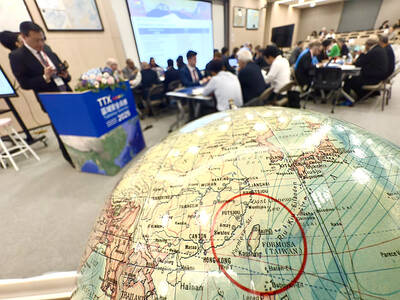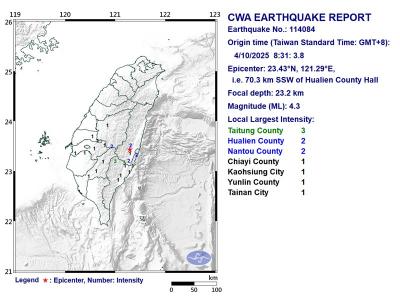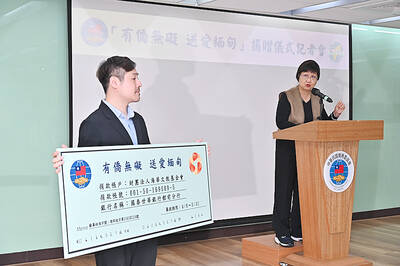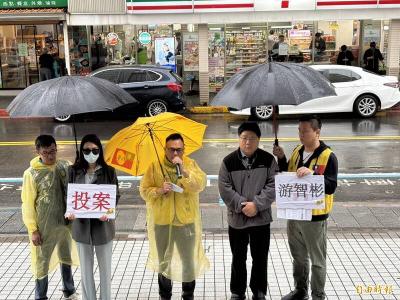The Makatao community in southern Taiwan on Wednesday last week submitted a formal request for government recognition, capping off three decades of activism.
Makatao elder Pan An-chuan (潘安全) of Pingtung County’s Neipu Township (內埔) told the Taipei Times that their struggle to gain recognition had received a big boost in recent years, with younger people joining and invigorating the movement by helping to form the Alliance of Makatao Communities.
Pan, a respected elder who has been involved in the Makatao indigenous rights movement since the beginning, is the head of the alliance.

Photo: Chen Yen-ting, Taipei Times
He handed over the documents to Yapasuyongu Poiconu, head of the Council of Indigenous Peoples’ Comprehensive Planning Department, at the event.
The Constitutional Court’s judgement No. 17 of 2022 gave the impetus for the Makatao to file an application for official recognition, as they have retained their cultural traditions, documented historical records and have a collective identity that is a distinct ethnicity, Pan said.
“The Makatao movement, whose aim is to achieve recognition as an ethnic group and gain official indigenous people status, started in the early 1990s. This road has taken us more than 30 years, and I have been fully engaged in this movement. It is an arduous road, and our bodies and feet are exhausted. We are happy to able to pass on the torch to the younger generation in recent years,” he said.
The main Makatao communities, about 2,000 people in total, live in villages along Pingtung’s “Mountain Foothill Highway,” or County Highway No. 185, Pan Wei-chin (潘韋縉), a Makatao youth leader, said during the interview.
“Throughout history, we have interacted with the Paiwan people and Han settlers. The elders used to speak Makatao, mixed with Hoklo and words from Paiwan, so it is difficult to rejuvenate our original mother tongue,” he said. “Most of our traditional attire and costumes have also been lost.”
“Although restoring our mother tongue is a very tough task, young Makatao have collected cultural artifacts from southern to northern Taiwan. We have been able to piece together traditional weaving patterns and cultural emblems, and have held workshops to learn the original Makatao ways of weaving and making traditional costumes. We have also added innovation and a modern interpretation to produce cultural attire and adornments using our distinct ethnic characteristics,” Pan Wei-chin said.
“We have earnestly striven for recognition. The most important thing is to find meaning in our identity as a distinct ethnic group... Even if we cannot fully restore our original language and traditions, we wish to hold on to our heritage and precious cultural elements. In doing so, we are affirming our ethnic identity, undertaking rejuvenation and passing these on to the next generation,” he added.
“Makatao is the seventh Pingpu plains indigenous group to have submitted an application for official recognition as an indigenous group,” said Yapasuyongu Poiconu, a Tsou.
“The council has accepted the application and will assess it in accordance with the provisions in the Indigenous Peoples Basic Act (原住民族基本法). It will also commission academics to conduct studies on its language, culture, self-identity as an ethnic group, traditions and rituals. It will be reviewed by a committee and, if approved, it would make an official report to the Executive Yuan to officially recognize the Makatao as an indigenous group,” he said.
“The Constitutional Court’s judgement No. 17 of 2022 sets a three-year deadline to complete the process, so legal requirements must be fulfilled by Oct. 28 next year. The procedures are under review at the Executive Yuan and are scheduled to be finished by the first legislative term next year. A study by academics is taking place concurrently, and when the amendments to legal statutes are approved next year, we expect the process for the Makatao to gain official indigenous status to be completed by June next year,” Yapasuyongu Poiconu said.
The request for recognition was a collaborative effort, with the alliance including members from the nine major Makatao communities in Pingtung County: Laopi, Ganabo, Zhong-lin, Chia-shuan, Gabulong, Wanchin, Chi-hu, Shi-tou and Sian-tan.
In past decades, the alliance had worked on cultural rejuvenation and to restore the collective Makatao identity. So far, there are three communities — Ganabo, Laopi and Gabulong — that celebrate the traditional Makatao festival in autumn, which have been officially approved as a “cultural heritage” by the Pingtung County Government, Pan An-chuan said.
“There are records of the Makatao people and their original communities by Han Chinese settlers during the Qing Dynasty. They can also be found in Dutch documents during the colonial era. They were known as the original inhabitants of ‘Fongshan’s Eight Communities’ (鳳山八社), whose traditional domains were on the Pingtung plains, and along the Gaoping River (高屏溪) and its tributaries, but were later forced to migrate to interior land due to pressure from Han Chinese settlers and indigenous groups in the mountains,” he added.
Some Makatao groups also migrated south to the Hengchun Peninsula (恆春), and to the eastern regions of Taitung and Hualien, the alliance said.
“Current Makatao settlements are a product of these waves of migration. Makatao communities live along Pingtung’s mountain foothills, the Hengchun Peninsula and villages in east coast counties. As a result, the Makatao have become the most widespread and have the largest population among the Pingpu,” he said.

DEFENSE: The National Security Bureau promised to expand communication and intelligence cooperation with global partners and enhance its strategic analytical skills China has not only increased military exercises and “gray zone” tactics against Taiwan this year, but also continues to recruit military personnel for espionage, the National Security Bureau (NSB) said yesterday in a report to the Legislative Yuan. The bureau submitted the report ahead of NSB Director-General Tsai Ming-yen’s (蔡明彥) appearance before the Foreign and National Defense Committee today. Last year, the Chinese People’s Liberation Army (PLA) conducted “Joint Sword-2024A and B” military exercises targeting Taiwan and carried out 40 combat readiness patrols, the bureau said. In addition, Chinese military aircraft entered Taiwan’s airspace 3,070 times last year, up about

A magnitude 4.3 earthquake struck eastern Taiwan's Hualien County at 8:31am today, according to the Central Weather Administration (CWA). The epicenter of the temblor was located in Hualien County, about 70.3 kilometers south southwest of Hualien County Hall, at a depth of 23.2km, according to the administration. There were no immediate reports of damage resulting from the quake. The earthquake's intensity, which gauges the actual effect of a temblor, was highest in Taitung County, where it measured 3 on Taiwan's 7-tier intensity scale. The quake also measured an intensity of 2 in Hualien and Nantou counties, the CWA said.

The Overseas Community Affairs Council (OCAC) yesterday announced a fundraising campaign to support survivors of the magnitude 7.7 earthquake that struck Myanmar on March 28, with two prayer events scheduled in Taipei and Taichung later this week. “While initial rescue operations have concluded [in Myanmar], many survivors are now facing increasingly difficult living conditions,” OCAC Minister Hsu Chia-ching (徐佳青) told a news conference in Taipei. The fundraising campaign, which runs through May 31, is focused on supporting the reconstruction of damaged overseas compatriot schools, assisting students from Myanmar in Taiwan, and providing essential items, such as drinking water, food and medical supplies,

New Party Deputy Secretary-General You Chih-pin (游智彬) this morning went to the National Immigration Agency (NIA) to “turn himself in” after being notified that he had failed to provide proof of having renounced his Chinese household registration. He was one of more than 10,000 naturalized Taiwanese citizens from China who were informed by the NIA that their Taiwanese citizenship might be revoked if they fail to provide the proof in three months, people familiar with the matter said. You said he has proof that he had renounced his Chinese household registration and demanded the NIA provide proof that he still had Chinese